Cost-Effective Mitigation of Greenhouse Gas Emissions in the Agriculture of Aragon, Spain
Abstract
:1. Introduction
2. Study Area
3. Materials and Methods
3.1. Evaluation and Selection of Mitigation Measures in Agriculture and Forestry
3.2. The MACC Approach
3.3. Transaction Costs and Costs of Measures
4. Results
4.1. Assessment of Agricultural GHG Emissions in Aragon
4.2. Mitigation Measures Assessment and Transaction Costs
4.3. Effect of Interaction between Measures
4.4. Mitigation Policy Scenarios
5. Discussion
6. Conclusions
Supplementary Materials
Author Contributions
Funding
Institutional Review Board Statement
Informed Consent Statement
Data Availability Statement
Conflicts of Interest
References
- IPCC. Summary for Policymakers. Climate Change 2014: Impacts, Adaptation, and Vulnerability. Part A: Global and Sectoral Aspects. Contribution of Working Group II to the Fifth Assessment Report of the Intergovernmental Panel on Climate Change; Cambridge University Press: Cambridge, UK, 2014. [Google Scholar]
- NASA-GISS. Global Mean Estimates Based on Land and Ocean Data; NASA Goddard Institute for Space Studies: New York, NY, USA, 2018. [Google Scholar]
- Mohammed, S.; Alsafadi, K.; Takács, I.; Harsányi, E. Contemporary changes of greenhouse gases emission from the agricultural sector in the EU-27. Geol. Ecol. Landsc. 2019, 1–6. [Google Scholar] [CrossRef] [Green Version]
- IPCC. Climate Change 2007: Synthesis Report. Contribution of Working Groups I, II and III to the Fourth Assessment Report of the IPCC; IPCC: Geneva, Switzerland, 2007. [Google Scholar]
- IPCC. Climate Change 2014: Synthesis Report. Contribution of Working Group I, II and III to the Fifth Assessment Report of the Intergovernmental Panel on Climate Change; IPCC: Geneva, Switzerland, 2014. [Google Scholar]
- Liu, S.; Xie, Z.; Liu, B.; Wang, Y.; Gao, J.; Zeng, Y.; Xie, J.; Xie, Z.; Jia, B.; Qin, P.; et al. Global river water warming due to climate change and anthropogenic heat emission. Glob. Planet. Chang. 2020, 193, 103–289. [Google Scholar] [CrossRef]
- Moragoda, N.; Cohen, S. Climate-induced trends in global riverine water discharge and suspended sediment dynamics in the 21st century. Glob. Planet. Chang. 2020, 191, 103–199. [Google Scholar] [CrossRef]
- Soutter, A.R.B.; Mõttus, R. Global warming versus climate change: A replication on the association between political self-identification, question wording, and environmental beliefs. J. Environ. Psychol. 2020, 69, 101413. [Google Scholar] [CrossRef]
- IPCC. Global Warming of 1.5 °C. An IPCC Special Report on the Impacts of Global Warming of 1.5 °C above Pre-industrial Levels and Related Global Greenhouse Gas Emission Pathways, in the Context of Strengthening the Global Response to the Threat of Climate Change, Sustainable Development, and Efforts to Eradicate Poverty; Masson-Delmotte, V., Zhai, P., Pörtner, H.O., Roberts, D., Skea, J., Shukla, P.R., Eds.; IPCC: Geneva, Switzerland, 2018. [Google Scholar]
- UNEP. Global Environment Outlook Geo-6, Healthy Planet, Healthy People; Cambridge University Press: Cambridge, UK, 2019; pp. iii–v. [Google Scholar] [CrossRef]
- UNFCCC. Adoption of the Paris Agreement; United Nations Framework Convention on Climate Change: Paris, France, 2015. [Google Scholar]
- MAPAMA. Inventory of Greenhouse Gas Emissions in Spain, Series 1990–2015. Summary Report. Secretary of State for the Environment, General Directorate for Environmental and Natural Quality and Assessment, General Sub-Directorate for Air Quality and Industrial Environment; Ministry of Agriculture, Fisheries, Food and Environment: Madrid, Spain, 2017.
- Smith, P. Soils and climate change. Curr. Opin. Environ. Sustain. 2012, 4, 539–544. [Google Scholar] [CrossRef]
- Hammad, H.M.; Nauman, H.M.F.; Abbas, F.; Ahmad, A.; Bakhat, H.F.; Saeed, S.; Shah, G.M.; Ahmad, A.; Cerdà, A. Carbon sequestration potential and soil characteristics of various land use systems in arid region. J. Environ. Manag. 2020, 264, 110254. [Google Scholar] [CrossRef]
- Ingram, J.; Mills, J.; Frelih-Larsen, A.; Davis, M.; Merante, P.; Ringrose, S.; Molnar, A.; Sánchez, B.; Ghaley, B.B.; Karaczun, Z. Managing Soil Organic Carbon: A Farm Perspective. EuroChoices 2014, 13, 12–19. [Google Scholar] [CrossRef]
- Kahil, T.; Albiac, J. Instrumentos de política de cambio climático en la agricultura de Aragón. Rev. Española Estud. Agrosoc. Pesq. 2012, 233, 13–42. [Google Scholar]
- Kahil, T.; Albiac, J. Greenhouse gases mitigation policies in the agriculture of Aragon, Spain. Bio-Based Appl. Econ. 2013, 2, 1–24. [Google Scholar]
- Plaza-Bonilla, D.; Alvaro-Fuentes, J.; Arrúe, J.L.; Cantero-Martínez, C. Tillage and nitrogen fertilization effects on nitrous oxide yield-scaled emissions in a rainfed Mediterranean area. Agric. Ecosyst. Environ. 2012, 189, 43–52. [Google Scholar] [CrossRef] [Green Version]
- Sánchez, B.; Iglesias, A.; McVittie, A.; Álvaro-Fuentes, J.; Ingram, J.; Mills, J.; Lesschen, J.P.; Kuikman, P.J. Management of agricultural soils for greenhouse gas mitigation: Learning from a case study in NE Spain. J. Environ. Manag. 2016, 170, 37–49. [Google Scholar] [CrossRef] [PubMed]
- Albiac, J.; Kahil, T.; Notivol, E.; Calvo, E. Agriculture and climate change: Potential for mitigation in Spain. Sci. Total Environ. 2017, 592, 495–502. [Google Scholar] [CrossRef] [PubMed] [Green Version]
- Pellerin, S.; Bamière, L.; Angers, D.; Béline, F.; Benoit, M.; Butault, J.P.; Chenu, C.; Colnenne-David, C.; De Cara, S.; Delame, N.; et al. Identifying cost-competitive greenhouse gas mitigation potential of French agriculture. Environ. Sci. Policy 2017, 77, 130–139. [Google Scholar] [CrossRef] [Green Version]
- CEDEX (Centro de Estudios y Experimentación de Obras Públicas). Evaluación del Impacto del Cambio Climático en los Recursos Hídricos y Sequías; Centro de Estudios Hidrográficos, MAPAMA: Madrid, Spain, 2017. [Google Scholar]
- Gobierno de Aragón. Calidad del agua de consumo humano en la Comunidad Autónoma de Aragón; Dirección General de Salud Pública, Gobierno de Aragón: Zaragoza, Spain, 2019.
- ESPON. Climate Change and Europe’s Regions. Featured Map. ESPON Climate Project Co-Financed by the European Regional Development Funds; TU Dortmund University: Dortmund, Germany, 2012. [Google Scholar]
- IAEST. Superficie de Aragón; Instituto Aragonés de Estadística, Gobierno de Aragón: Zaragoza, Spain, 2018. [Google Scholar]
- MAPAMA. Encuesta Sobre Superficies y Rendimientos de Cultivos: Informe Sobre Regadíos en España (ESYRCE); Subdirección General de Estadística, Secretaria General Técnica, Ministerio de Agricultura, Pesca, Alimentación y Medio Ambiente: Madrid, Spain, 2017.
- Gobierno de Aragon. La Producción Agraria en Aragón, Documento de Síntesis; Sección de Estadística del Departamento de Agricultura y Alimentación: Zaragoza, Spain, 2017.
- Smith, S.; Braathen, N. Monetary Carbon Values in Policy Appraisal: An Overview of Current Practice and Key Issues. Environ. Work. Pap. 2015, 92. [Google Scholar] [CrossRef]
- IPCC. Agricultura, Silvicultura y Otros Usos de la Tierra, Capítulo 1: Introducción. Directrices del IPCC de 2006 Para los Inventarios Nacionales de Gases de Efecto Invernadero; IPCC: Geneva, Switzerland, 2006. [Google Scholar]
- IPCC. 2019 Refinement to the 2006 IPCC Guidelines for National Greenhouse Gas Inventories; IPCC: Geneva, Switzerland, 2019. [Google Scholar]
- EEA. CH4 Emission Factors; European Environment Agency: Copenhagen, Denmark, 2014.
- IPCC. Agricultura, Capitulo 4: Orientación del IPCC sobre las Buenas Prácticas y la Gestión de la Incertidumbre en los Inventarios Nacionales de Gases de Efecto Invernadero; IPCC: Geneva, Switzerland, 2006. [Google Scholar]
- Moran, D.; MacLeod, M.; Wall, E.; Eory, V.; Pajot, G.; Matthews, R.; McVittie, A.; Barnes, A.; Rees, B.; Moxey, A.; et al. UK Marginal Abatement Cost Curves for the Agriculture and Land Use, Land-Use Change and Forestry Sectors out to 2022, with Qualitative Analysis of Options to 2050; Final Report to the Committee on Climate Change; Scottish Agricultural College: Perth, UK, 2008. [Google Scholar]
- Schulte, R.; Crosson, P.; Donnellan, T.; Farrelly, N.; Finnan, J.; Lanigan, G.; O’Brien, D.; Shalloo, L.; Thorne, F. A Marginal Abatement Cost Curve for Irish Agriculture; Teagasc: Carlow, Ireland, 2012. [Google Scholar]
- Crespo, D.; Albiac, J.; Kahil, T.; Esteban, E.; Baccour, S. Tradeoffs between Water Uses and Environmental Flows: A Hydroeconomic Analysis in the Ebro Basin. Water Resour. Manag. 2019, 33, 2301–2317. [Google Scholar] [CrossRef] [Green Version]
- Baccour, S.; Albiac, J.; Esteban, E. Modelización Hidroeconómica de la Contaminación Difusa y la Escasez de Agua en la Cuenca del Ebro. Available online: https://citarea.cita-aragon.es/citarea/bitstream/10532/5064/3/2020_213.pdf (accessed on 25 January 2021).
- Asgedom, H.; Kebreab, E. Beneficial management practices and mitigation of greenhouse gas emissions in the agriculture of the Canadian Prairie: A review. Agron. Sustain. Dev. 2011, 31, 433–451. [Google Scholar] [CrossRef] [Green Version]
- Burney, J.A.; Davis, S.J.; Lobell, D.B. Greenhouse gas mitigation by agricultural intensification. Proc. Natl. Acad. Sci. USA 2010, 107, 12052–12057. [Google Scholar] [CrossRef] [Green Version]
- Wilhelm, W.W.; Johnson, J.M.F.; Hatfield, J.L.; Voorhees, W.B.; Linden, D.R. Crop and soil productivity response to corn residue removal. J. Agron. 2004, 96, 1–17. [Google Scholar] [CrossRef]
- Kell, D.B. Large-scale sequestration of atmospheric carbon via plant roots in natural and agricultural ecosystems: Why and how. Philos. Trans. R. Soc. B 2012, 367, 1589–1597. [Google Scholar] [CrossRef] [Green Version]
- Poeplau, C.; Don, A. Carbon sequestration in agricultural soils via cultivation of cover crops: A meta-analysis. Agric. Ecosyst. Environ. 2015, 200, 33–41. [Google Scholar] [CrossRef]
- Ogle, S.M.; Breidt, F.J.; Paustian, K. Agricultural management impacts on soil organic carbon storage under moist and dry climatic conditions of temperate and tropical regions. Biogeochemistry 2005, 72, 87–121. [Google Scholar] [CrossRef]
- Thornton, P.K.; Herrero, M. Potential for reduced methane and carbon dioxide emissions from livestock and pasture management in the tropics. Proc. Natl. Acad. Sci. USA 2010, 107, 19667–19672. [Google Scholar] [CrossRef] [PubMed] [Green Version]
- Martin, C.; Morgavi, D.; Doreau, M. Methane mitigation in ruminants: From microbe to the farm scale. Animal 2010, 4, 351–365. [Google Scholar] [CrossRef] [PubMed] [Green Version]
- Herrero, M.; Henderson, B.; Havlík, P.; Thornton, P.K.; Conant, R.T.; Smith, P.; Wirsenius, S.; Hristov, A.N.; Gerber, P.; Gill, M.; et al. Greenhouse gas mitigation potentials in the livestock sector. Nat. Clim. Chang. 2016, 6, 452–461. [Google Scholar] [CrossRef] [Green Version]
- Bravo, F. El Papel de los Bosques Españoles en la Mitigación del Cambio Climático; Fundación Gas Natural: Barcelona, Spain, 2007. [Google Scholar]
- Ruiz-Peinado, R.; Bravo-Oviedo, A.; López-Senespleda, E.; Bravo, F.; Río, M. Forest management and carbon sequestration in the Mediterranean region: A review. For. Syst. 2017, 26, eR04S. [Google Scholar] [CrossRef]
- McCarl, B.A.; Schneider, U.A. U.S. Agriculture’s Role in a Greenhouse Gas Emission Mitigation World: An Economic Perspective. Appl. Econ. Perspect Policy 2000, 22, 134–159. [Google Scholar] [CrossRef] [Green Version]
- MacLeod, M.; Moran, D.; Eory, V.; Rees, R.M.; Barnes, A.; Topp, C.F.E.; Ball, B.; Hoad, S.; Wall, E.; McVittie, A.; et al. Developing greenhouse gas marginal abatement cost curves for agricultural emissions from crops and soils in the UK. Agric. Syst. 2010, 103, 198–209. [Google Scholar] [CrossRef]
- Moran, D.; Macleod, M.; Wall, E.; Eory, V.; McVittie, A.; Barnes, A.; Rees, R.; Topp, C.F.E.; Moxey, A. Marginal Abatement Cost Curves for UK Agricultural Greenhouse Gas Emissions. J. Agric. Econ. 2011, 62, 93–118. [Google Scholar] [CrossRef]
- Wang, W.; Koslowski, F.; Nayak, D.R.; Smith, P.; Saetnan, E.; Ju, X.; Guo, L.; Han, G.; Perthuis, C.D.; Lin, E.; et al. Greenhouse gas mitigation in Chinese agriculture: Distinguishing technical and economic potentials. Glob. Environ. Chang. 2014, 26, 53–62. [Google Scholar] [CrossRef] [Green Version]
- Moran, D.; Lucas, A.; Barnes, A. Mitigation win–win. Nat. Clim. Chang. 2013, 3, 611–613. [Google Scholar] [CrossRef]
- Lal, R.; Bruce, J.P. The potential of world cropland soils to sequester C and mitigate the greenhouse effect. Environ. Sci. Policy 1999, 2, 177–185. [Google Scholar] [CrossRef]
- Sanz-Cobena, A.; Lassaletta, L.; Aguilera, E.; Prado, A.; Garnier, J.; Billen, G.; Iglesias, A.; Sánchez, B.; Guardia, G.; Abalos, D.; et al. Strategies for greenhouse gas emissions mitigation in Mediterranean agriculture: A review. Agric. Ecosyst. Environ. 2017, 238, 5–24. [Google Scholar] [CrossRef] [Green Version]
- González-Sánchez, E.J.; Ordóñez-Fernández, R.; Carbonell-Bojollo, R.; Veroz-González, O.; Gil-Ribes, J.A. Meta-analysis on atmospheric carbon capture in Spain through the use of conservation agriculture. Soil Tillage Res. 2012, 122, 52–60. [Google Scholar] [CrossRef]
- Forte, A.; Fiorentino, N.; Fagnano, M.; Fierro, A. Mitigation impact of minimum tillage on CO2 and N2O emissions from a Mediterranean maize cropped soil under low-water input management. Soil Tillage Res. 2017, 166, 167–178. [Google Scholar] [CrossRef]
- Teresa, M.; Herrero, E.; Bescós, B. Evaluación de Sistemas de Gestión de Estiércol en Europa. Resultados del Proyecto LIFE-MANEV; Sociedad Aragonesa de Gestión Ambiental: Zaragoza, Spain, 2016. [Google Scholar]
- Liu, Z.; Shen, J. Measuring Transaction Costs: Theoretic Development and Application. Financ. Trade Econ. 2006, 10, 77–82. [Google Scholar]
- Cheung, S. The Transaction Costs Paradigm: 1998 Presidential Address, Western Economic Association. Econ. Inq. 1998, 36, 514–521. [Google Scholar] [CrossRef]
- Dahlman, C.J. The Problem of Externality. J. Law Econ. 1979, 22, 141–162. [Google Scholar] [CrossRef] [Green Version]
- McCann, L. Transaction costs and environmental policy design. Ecol. Econ. 2013, 88, 253–268. [Google Scholar] [CrossRef]
- Garrick, D. Transaction costs and environmental policy: Taking stock, looking forward. Ecol. Econ. 2013, 88, 182–184. [Google Scholar] [CrossRef]
- Howitt, R.E. Empirical analysis of water market institutions: The 1991 California water market. Resour. Energy Econ. 1994, 16, 357–371. [Google Scholar] [CrossRef]
- McCann, L.M.J.; Easter, K.W. Estimates of public transaction costs in NRCS programs. J. Agric. Appl. Econ. 2000, 32, 555–563. [Google Scholar] [CrossRef] [Green Version]
- Mettepenningen, E.; Verspecht, A.; Huylenbroeck, G.V. Measuring private transaction costs of European agri-environmental schemes. J. Environ. Plan. Manag. 2009, 52, 649–667. [Google Scholar] [CrossRef]
- Coggan, A.; Whitten, S.M.; Bennett, J. Influences of transaction costs in environmental policy. Ecol. Econ. 2010, 69, 1777–1784. [Google Scholar] [CrossRef]
- Rorsted, P.; Vatn, A.; Kvakkestad, V. Why do transaction costs of agricultural policies vary? Agric. Econ. 2007, 36, 1–11. [Google Scholar] [CrossRef]
- Kahil, T. Instrumentos de Mitigación y Adaptación al Cambio Climático en la Agricultura de Aragón. Master’s Thesis, Instituto Agronómico Mediterránea de Zaragoza (IAMZ-CIHEAM), Zaragoza, Spain, 2011. [Google Scholar]
- Cui, Z.; Zhang, H.; Chen, X.; Zhang, C.; Ma, W.; Huang, C.; Zhang, W.; Mi, G.; Miao, Y.; Li, X.; et al. Pursuing sustainable productivity with millions of smallholder farmers. Nature 2018, 555, 7696. [Google Scholar] [CrossRef]
- Clark, M.A.; Domingo, N.G.G.; Colgan, K.; Thakrar, S.K.; Tilman, D.; Lynch, J.; Azevedo, I.L.; Hill, J.D. Global food system emissions could preclude achieving the 1.5° and 2°C climate change targets. Science 2020, 370, 705–708. [Google Scholar] [CrossRef]
- Orús, F. Fertilización Nitrogenada: Guía de Actualización. Informaciones Técnicas, Número Extraordinario; Centro de Transferencia Agroalimentaria, Dirección General de Desarrollo Rural: Zaragoza, Spain, 2006. [Google Scholar]
- Mema, M. Las Políticas de Control de la Contaminación Difusa en el Valle Medio del Ebro. Ph.D. Thesis, Universidad de Zaragoza, Zaragoza, Spain, 2006. [Google Scholar]
- Conniff, R. Scrubbing Carbon from the Sky: Can we remove enough CO2 from the atmosphere to slow or even reverse climate change? Sci. Am. 2019, 320, 52–59. [Google Scholar] [CrossRef]
- Albiac, J.; Soriano, J.S.; Dinar, A. Game theory: A useful approach for policy evaluation in natural resources and the environment. In Game Theory and Policymaking in Natural Resources and the Environment; Albiac, J., Soriano, J.S., Dinar, A., Eds.; Routledge: London, UK, 2008; pp. 1–11. [Google Scholar]
- Jiao, X.; Lyu, Y.; Wu, X.; Li, H.; Cheng, L.; Zhang, C.; Yuan, L.; Jiang, R.; Jiang, B.; Rengel, Z.; et al. Grain production versus resource and environmental costs: Towards increasing sustainability of nutrient use in China. J. Exp. Bot. 2016, 67, 4935–4949. [Google Scholar] [CrossRef]
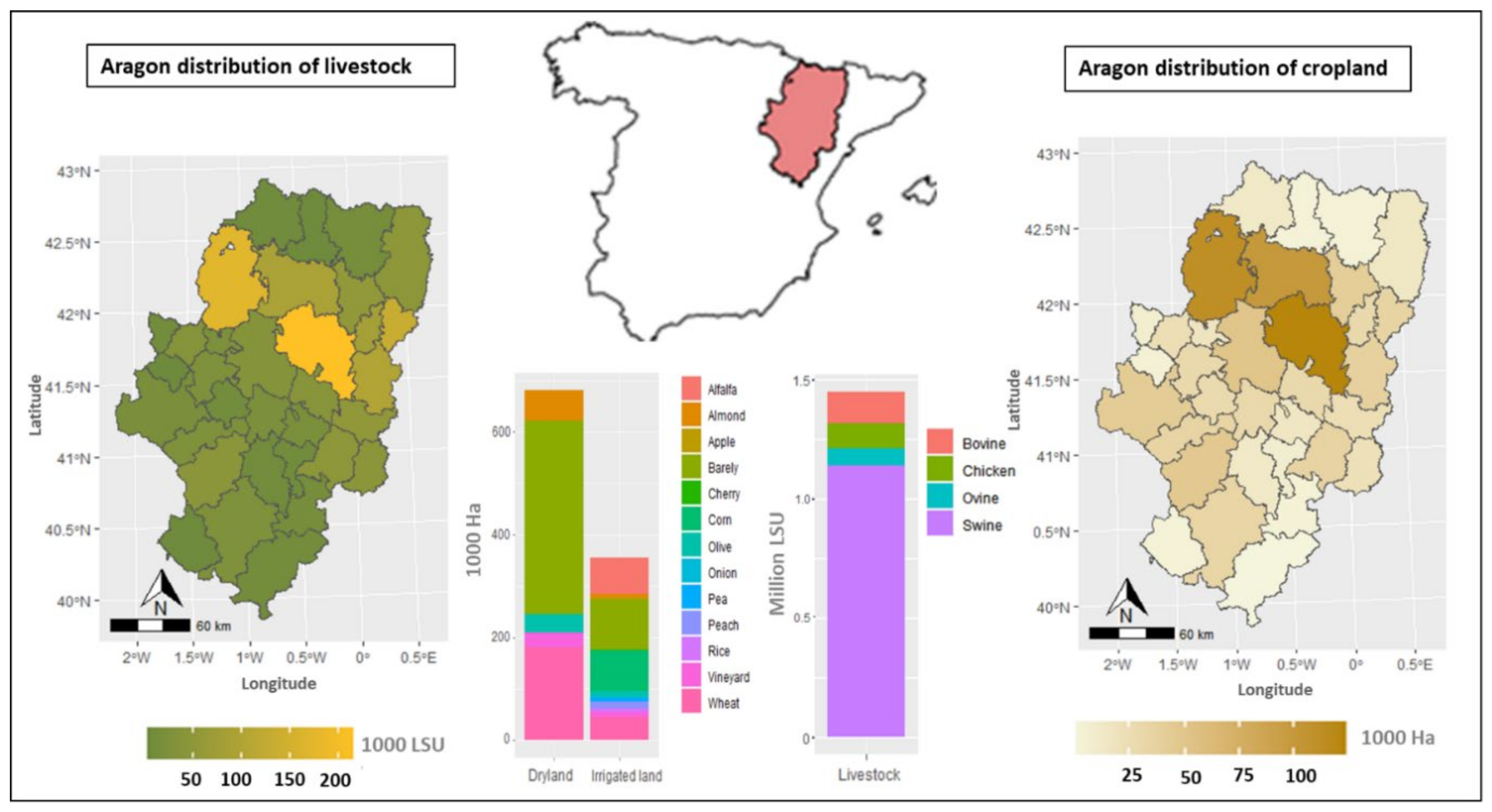
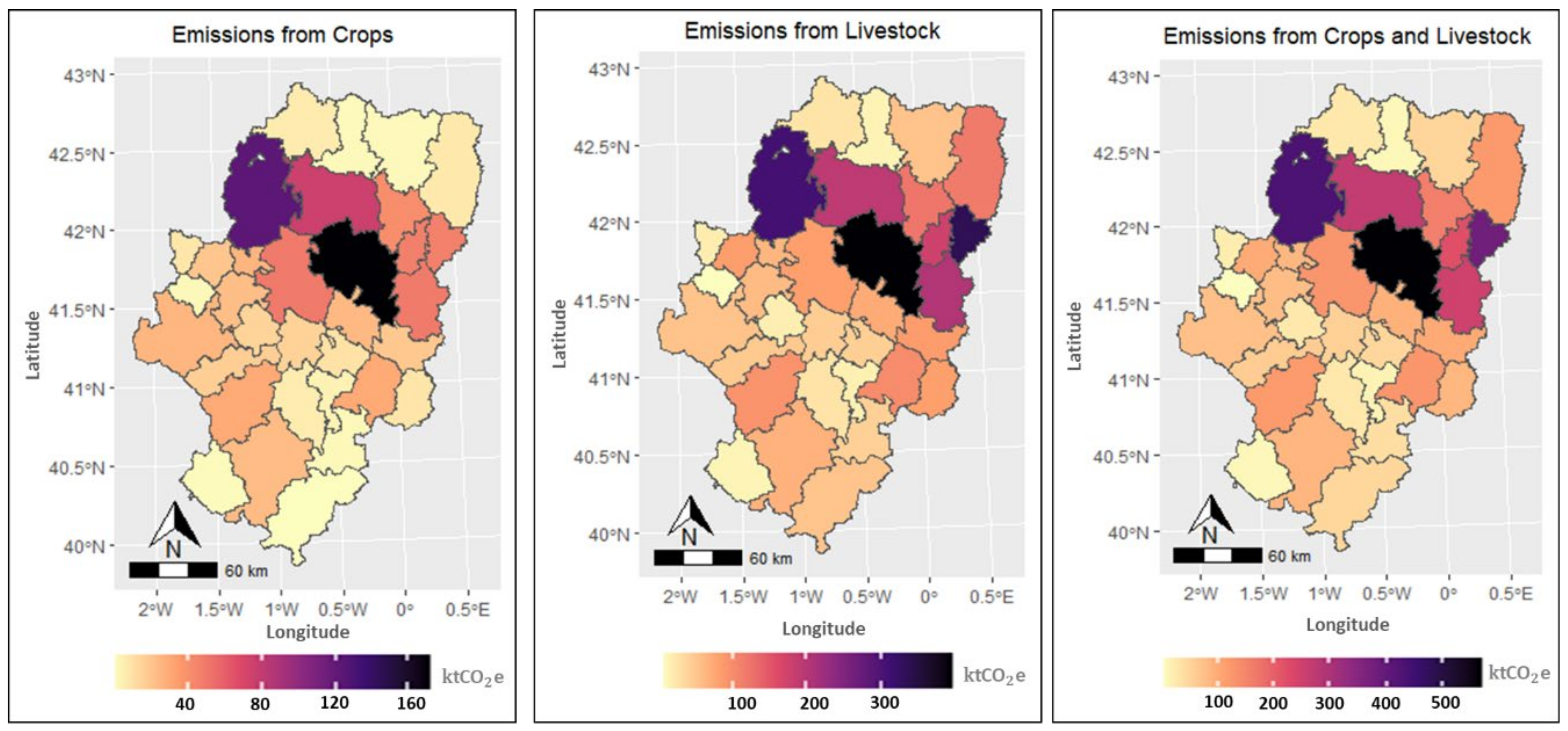
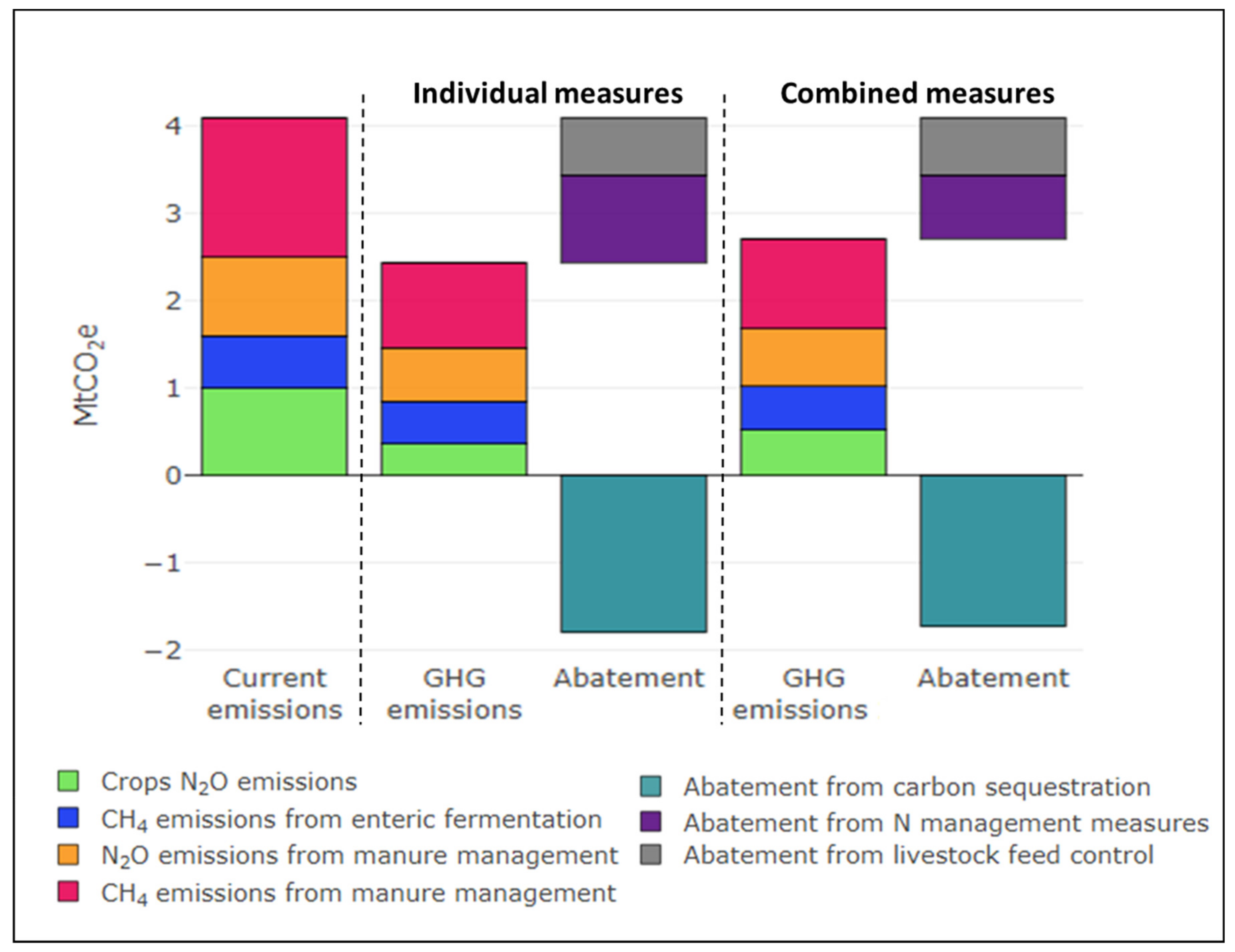
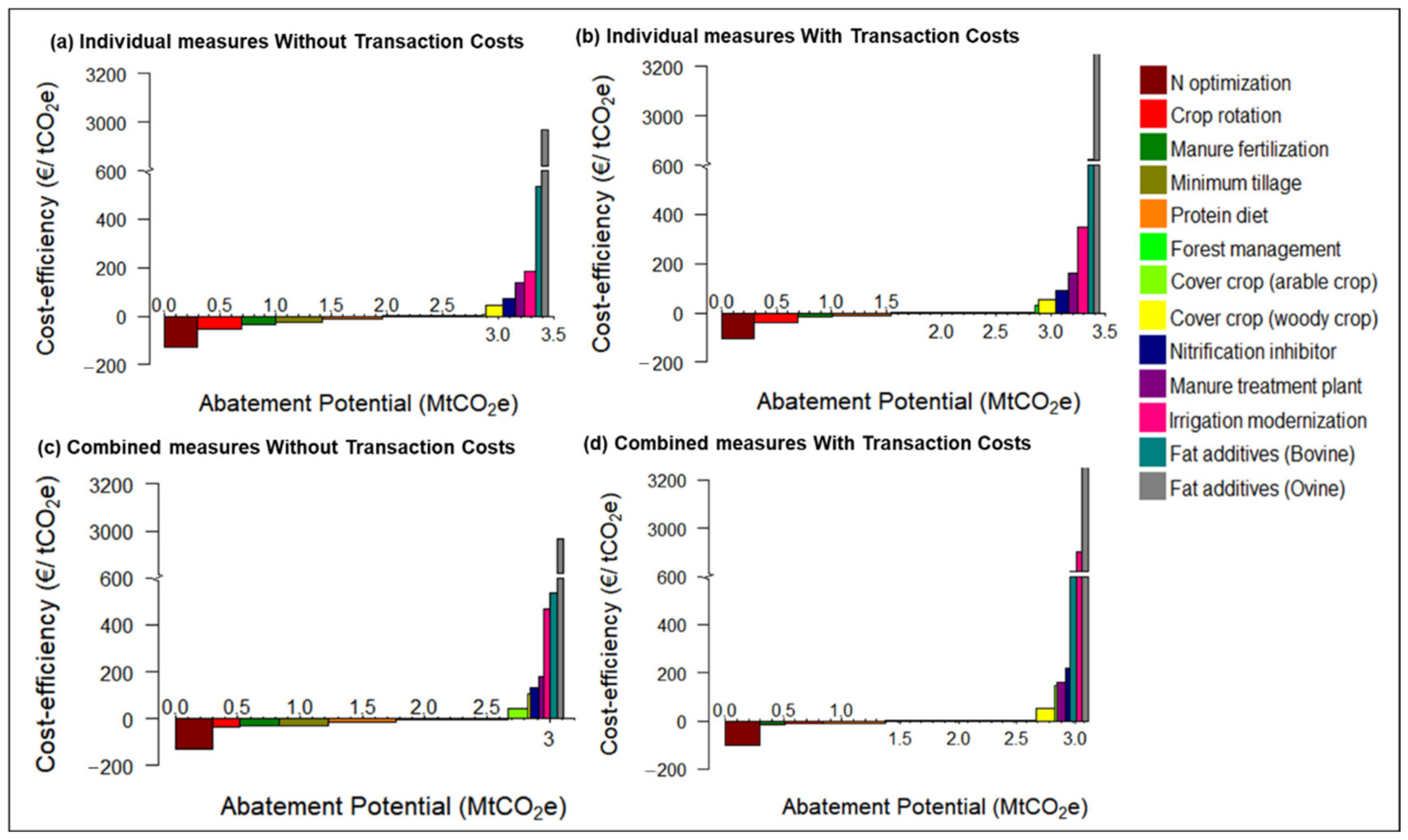
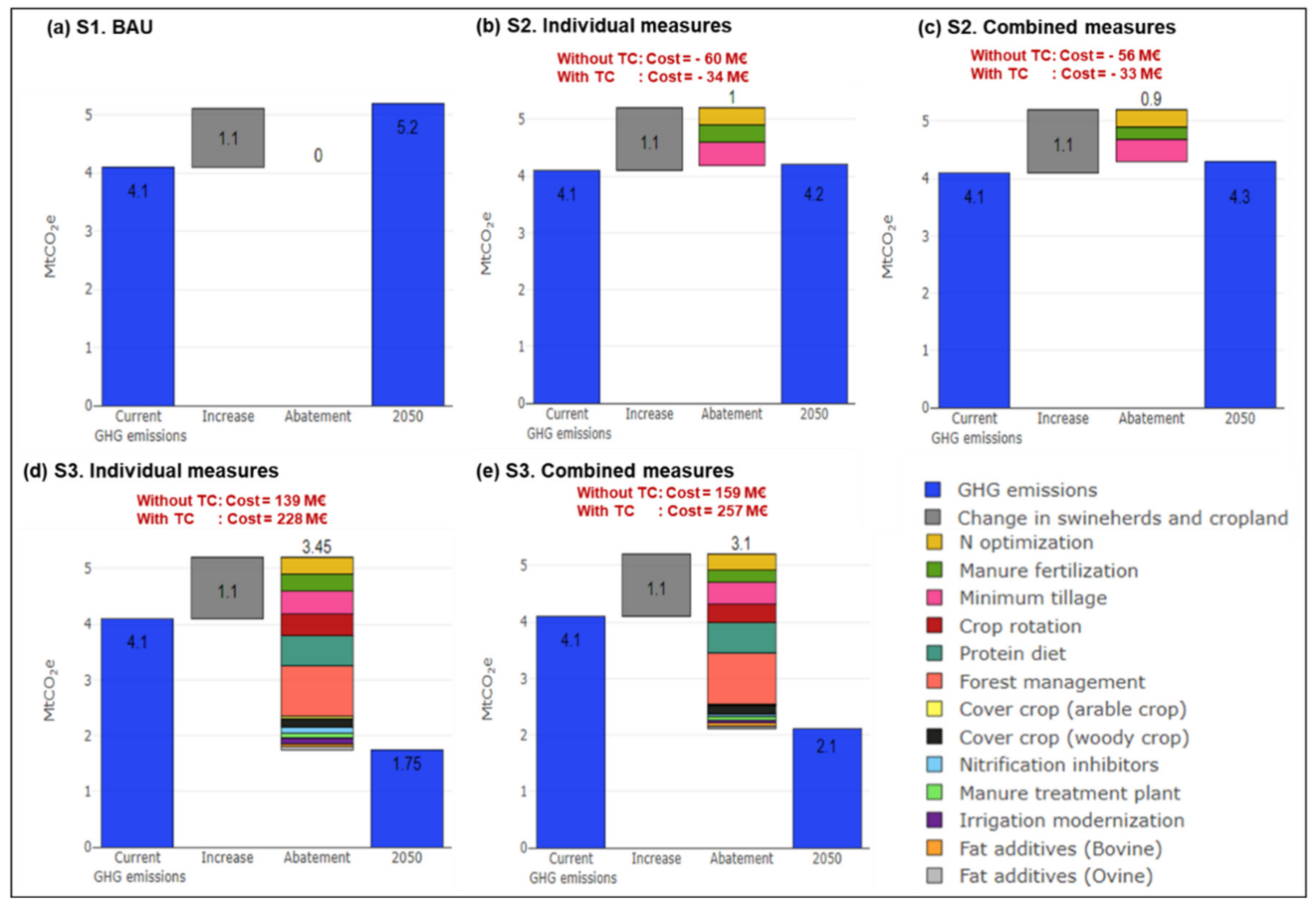
| Measures | Description |
|---|---|
| Crop measures | |
| N optimization | Efficient application of nitrogen fertilization according to the optimal requirements of each crop. |
| Crop rotation with legumes | Crop rotation increases soil carbon sequestration by 0.125 Mg/ha/year and reduces mineral fertilization by 50% [19,53]. |
| Cover crops | Cover crops increase carbon sequestration in the soil by 0.35 Mg C/ha/year in woody crops, and reduce greenhouse gas (GHG) emissions by 10% in arable crops [54,55]. |
| Minimum tillage | Minimum tillage practices reduce GHG emissions by 0.47 tCO2e/ha/year in cereals and 28% in corn [56]. |
| Nitrification inhibitors | Adding inhibitors in the soil increases the efficiency of nitrogen use and reduces N2O emissions by 30% [54]. |
| Irrigation modernization | Replacing surface irrigation by sprinkler and drip systems increases the efficiency of water and nitrogen application. |
| Livestock measures | |
| Manure fertilization | Increasing the share of manure nitrogen fertilization from current 27% to 60%. |
| Fat additives | Adding 1% of fat reduces CH4 emissions from enteric fermentation by 4% [44]. |
| Manure treatment plants | Manure treatment plants reduce N2O emissions by 60% using nitrification and denitrification processes in plants with 50,000 m3/year capacity [57]). |
| Decrease of protein in the diet of swine | Adjusting the protein content in feeds reduces nitrogen excretion by 8.5%. |
| Forest measures | |
| Forest management | Adoption of forest management techniques for carbon sequestration. |
| Crops | Land (1000 ha) | N Fertilization (kg/ha) | N Leached (kg/ha) | ||||||
|---|---|---|---|---|---|---|---|---|---|
| Dryland | 679 | ||||||||
| Cereals | 558 | ||||||||
| Barley | 377 | 77 | 8 | ||||||
| Wheat | 181 | 45 | 5 | ||||||
| Fruit trees | 121 | ||||||||
| Olive | 36 | 60 | 6 | ||||||
| Vineyard | 27 | 45 | 5 | ||||||
| Almond | 58 | 45 | 5 | ||||||
| Surface | Sprinkler | Drip | Surface | Sprinkler | Drip | Surface | Sprinkler | Drip | |
| Irrigated land | 207 | 125 | 25 | ||||||
| Cereals | |||||||||
| Barley | 74 | 23 | 200 | 150 | 38 | 25 | |||
| Corn | 22 | 57 | 450 | 350 | 200 | 120 | |||
| Alfalfa | 37 | 33 | 85 | 56 | 32 | 21 | |||
| Wheat | 33 | 12 | 200 | 180 | 48 | 22 | |||
| Rice | 7 | 200 | 50 | ||||||
| Vegetables | |||||||||
| Pea | 4 | 3 | 90 | 60 | 16 | 10 | |||
| Onion | 1 | 1 | 200 | 140 | 33 | 23 | |||
| Fruit trees | |||||||||
| Peach | 6 | 7 | 200 | 150 | 60 | 45 | |||
| Olive | 9 | 2 | 120 | 100 | 36 | 30 | |||
| Vineyard | 5 | 5 | 120 | 100 | 36 | 30 | |||
| Almond | 6 | 2 | 100 | 80 | 30 | 24 | |||
| Cherry | 2 | 2 | 100 | 80 | 30 | 24 | |||
| Apple | 1 | 2 | 150 | 130 | 45 | 39 | |||
| Animals | Livestock (1000 heads) | N excreted (kg/animal/year) | |||||||
| Swine | 6309 | 9 | |||||||
| Sheep | 1800 | 9 | |||||||
| Beef cattle | 306 | 45 | |||||||
| Dairy cattle | 15 | 80 | |||||||
| Chicken | 27,283 | 0.4 | |||||||
Publisher’s Note: MDPI stays neutral with regard to jurisdictional claims in published maps and institutional affiliations. |
© 2021 by the authors. Licensee MDPI, Basel, Switzerland. This article is an open access article distributed under the terms and conditions of the Creative Commons Attribution (CC BY) license (http://creativecommons.org/licenses/by/4.0/).
Share and Cite
Baccour, S.; Albiac, J.; Kahil, T. Cost-Effective Mitigation of Greenhouse Gas Emissions in the Agriculture of Aragon, Spain. Int. J. Environ. Res. Public Health 2021, 18, 1084. https://doi.org/10.3390/ijerph18031084
Baccour S, Albiac J, Kahil T. Cost-Effective Mitigation of Greenhouse Gas Emissions in the Agriculture of Aragon, Spain. International Journal of Environmental Research and Public Health. 2021; 18(3):1084. https://doi.org/10.3390/ijerph18031084
Chicago/Turabian StyleBaccour, Safa, Jose Albiac, and Taher Kahil. 2021. "Cost-Effective Mitigation of Greenhouse Gas Emissions in the Agriculture of Aragon, Spain" International Journal of Environmental Research and Public Health 18, no. 3: 1084. https://doi.org/10.3390/ijerph18031084
APA StyleBaccour, S., Albiac, J., & Kahil, T. (2021). Cost-Effective Mitigation of Greenhouse Gas Emissions in the Agriculture of Aragon, Spain. International Journal of Environmental Research and Public Health, 18(3), 1084. https://doi.org/10.3390/ijerph18031084







